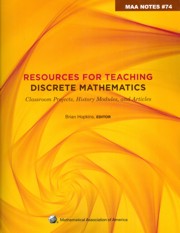Book contents
- Frontmatter
- Introduction
- Dedication
- Contents
- I Classroom-tested Projects
- II Historical Projects in Discrete Mathematics and Computer Science
- Introduction
- Binary Arithmetic: From Leibniz to von Neumann
- Arithmetic Backwards from Shannon to the Chinese Abacus
- Pascal's Treatise on the Arithmetical Triangle: Mathematical Induction, Combinations, the Binomial Theorem and Fermat's Theorem
- Early Writings on Graph Theory: Euler Circuits and The Königsberg Bridge Problem
- Counting Triangulations of a Convex Polygon
- Early Writings on Graph Theory: Hamiltonian Circuits and The Icosian Game
- Are All Infinities Created Equal?
- Early Writings on Graph Theory: Topological Connections
- A Study of Logic and Programming via Turing Machines
- Church's Thesis
- Two-Way Deterministic Finite Automata
- III Articles Extending Discrete Mathematics Content
- IV Articles on Discrete Mathematics Pedagogy
- About the Editor
A Study of Logic and Programming via Turing Machines
from II - Historical Projects in Discrete Mathematics and Computer Science
- Frontmatter
- Introduction
- Dedication
- Contents
- I Classroom-tested Projects
- II Historical Projects in Discrete Mathematics and Computer Science
- Introduction
- Binary Arithmetic: From Leibniz to von Neumann
- Arithmetic Backwards from Shannon to the Chinese Abacus
- Pascal's Treatise on the Arithmetical Triangle: Mathematical Induction, Combinations, the Binomial Theorem and Fermat's Theorem
- Early Writings on Graph Theory: Euler Circuits and The Königsberg Bridge Problem
- Counting Triangulations of a Convex Polygon
- Early Writings on Graph Theory: Hamiltonian Circuits and The Icosian Game
- Are All Infinities Created Equal?
- Early Writings on Graph Theory: Topological Connections
- A Study of Logic and Programming via Turing Machines
- Church's Thesis
- Two-Way Deterministic Finite Automata
- III Articles Extending Discrete Mathematics Content
- IV Articles on Discrete Mathematics Pedagogy
- About the Editor
Summary
An Introduction to Turing Machines
During the International Congress of Mathematicians in Paris in 1900 David Hilbert (1862–1943), one of the leading mathematicians of the last century, proposed a list of problems for following generations to ponder [8, p. 290–329], [9]. On the list was whether the axioms of arithmetic are consistent, a question which would have profound consequences for the foundations of mathematics. Continuing in this direction, in 1928 Hilbert proposed the decision problem (das Entscheidungsproblem) [10, 11, 12], which asked whether there was a standard procedure that can be applied to decide whether a given mathematical statement is true. Both Alonzo Church (1903–1995) [2, 3] and Alan Turing (1912–1954) [13] published papers in 1936 demonstrating that the decision problem has no solution, although it is the algorithmic character of Turing's paper “On Computable Numbers, with an Application to the Entscheidungsproblem” [13] that forms the basis for the modern programmable computer. Today his construction is known as a Turing machine.
Let's first study a few excerpts from Turing's original paper [13, p. 231–234], and then design a few machines to perform certain tasks.
ON COMPUTABLE NUMBERS, WITH AN APPLICATION TO THE ENTSCHEIDUNGSPROBLEM
By A. M. Turing
Computing Machines.
We have said that the computable numbers are those whose decimals are calculable by finite means. This requires more explicit definition. No real attempt will be made to justify the definitions given until we reach §9.
- Type
- Chapter
- Information
- Resources for Teaching Discrete MathematicsClassroom Projects, History Modules, and Articles, pp. 241 - 252Publisher: Mathematical Association of AmericaPrint publication year: 2009



